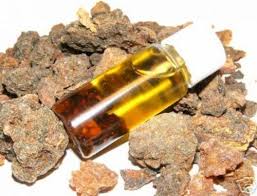ASAFETIDA - Essential Oil - Ferula asa-foetida






ASAFETIDA-Ferula asa-foetida
Family: Apiaceae (Umbelliferae)
Synonyms: Asafoetida, gum asafetida, devil's dung, food of the gods, giant fennel.
General Description : A large branching perennial herb up to 3 metres high, with a thick fleshy root system and pale yellow-green flowers.
Distribution: Native to Afghanistan, Iran and other regions of South west Asia.
Other Species: There are several other species of Ferula which yield the oleoresin known as 'asafetida', e.g. Tibetan asafetida, which is also used to a lesser extent in commerce.
Herbal/Folk Tradition: In Chinese medicine it has been used since the seventh century as a nerve stimulant in treating neurasthenia. It is also widely used in traditional Indian medicine, wher it is believed to stimulate the brain. In general, it has the reputation for treating various ailments including asthma, bronchitis, convulsions, coughts, constipation, flatulence and hysteria.The foliage of the plant is used as a local vegetable. It is current in the British Herbal pharmacopoeia as a specific for intestinal flatulence colic.
Actions: Antispasmodic, carminative, expectorant, hypotensive, stimulant, Animals are repelled by its odour.
Extraction: The oleoresin is obtained by making incisions into the root and above the ground parts of the plant. The milky juice is left to leak out and harden into dark reddish lumps, before being scraped off and collected. The essential oil is then obtained from the resin by steam distillation. An absolute, resinoid and tincture are also produced.
Characteristics: A yellow-orange oil with a bitter acrid taste and a strong, tenacious odour resembling garlic. However, beneath this odour there is a sweet, balsamic note.
Principal Constituents: Disulphides, notably 2-butyl propenyl disulphide with monoterpenes, free ferulic acid, valeric, traces of vanillin, among others.
Safety Data: Available information indicates the oil be relatively non-toxic and non-irritant. However, it has the reputation for being the most adulterated 'drug' on the market. Before being sold, the oleoresin is often mixed with red clay or similar substitutes.
Aromatherapy/Home Use
Respiratory system:'There is evidence that the volatile oil is expelled through the lungs,thyerefore it is excellent for asthma, bronchitis,whooping cough etc.
Nervous system: Fatigue, nervous exhaustion and stress-related conditions.
Other Uses
Now rarely used in pharmaceutical preparations; formely used as a local stimulant for mucous membranes. Occasionally used as a fixative and fragrance component in perfumes,especially rose bases and heavy orential types. Employed in a wide variety of food categories,mainly condiments and sauces.
Reference: The Encyclopedia of Essential oils: Julia Lawless
Articles Latest
- CARDAMON
- CARAWAY
- CANANGA
- CAMPHOR
- CALAMUS
- Calamintha-Calamintha officinalis
- CAJEPUT- Melaleuca cajeputi
- Plant Expression
- Molecular Target: Cell Membrane
- CADE Essential Oil
- CABREUVA
- The Kashmiri rose oil worth millions
- Agarwood: The natural treasure worth more than gold whose heady scent is driving it towards extinction
- Nonselective Binding to Proteins: The Science of Advanced Aromatherapy
- Molecular Target: DNA, RNA, and Gene Expression
- BUCHU - Agothosma betulina
- BROOM - SPANISH - spartium junceum
- BORONiA - Boronia megastigma
- BORNEOL - Dryobalanops aromantica
- Boldo Leaf - Peumus boldus
- Birch White-Betula Alba
Articles-Most Read
- Home
- Balsam Canadian - Abies balsamea
- Copaiba Essential Oil
- Balsam Peru
- Basil French - Ocimum basilicum
- North America: Tea Tree and Monarda-3
- Basil Exotic
- North America: Tea Tree and Monarda-2
- Exploring Transcultural Constants
- Thyme Essential Oil
- Balsam Tolu
- Palma Rosa
- The Bioactivity of Essential Oils
- Benzoin - Styrax benzoin
- Why Pharmacology Cannot Demonstrate Essential Oil Efficacy
- Bay - West Indian - Pimenta racemosa
- Exploring Essential Oil Activity The Conventional Way
- Aromatherapy: An Answer
- Complex information From Plants
- Contacts
